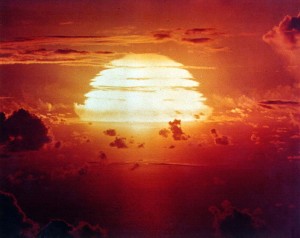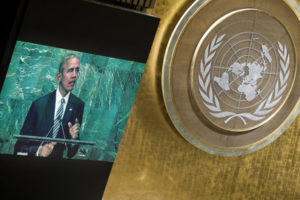Obama’s Unkept Promise on Nuclear War
Exclusive: By ratcheting up tensions with Russia, U.S. national security is raising risks of accidental nuclear war with missiles still on hair-trigger alert — despite President Obama’s promises, writes Jonathan Marshall.
With little more than a week left in President Obama’s last term, arms control experts still hope he will finally make good on a promise he made in 2008: to make America safer by taking our weapons of mass destruction off hair-trigger alert.
A petition to that effect by Ploughshares Fund, a San Francisco-based foundation dedicated to advancing the control of nuclear arms, has garnered more than 85,000 signatures. Unless Obama acts, it notes ominously, “President Trump could launch 140 warheads in the time it takes to write 140 characters. The grave difference is: a tweet can be deleted, but the devastation of a nuclear warhead can never be undone.”
Experts estimate that about 1,000 U.S. nuclear warheads are currently set to launch within minutes of a presidential order to vaporize an enemy. As Ploughshares Fund President Joe Cirincione observes, “Each is many times the size of the bombs we dropped on Japan. Together, they can explode the equivalent of 22,000 Hiroshima’s on cities all over the planet. In just 30 minutes, they could destroy all that human civilization has created over the millennia.”
There was once a method to this madness. Our ability to launch missiles on warning of an incoming attack prevented any chance that the Soviet Union could strike first, wipe out our nuclear arsenal, and then dictate the terms of (a very radioactive) peace. The same was true in reverse, at least until the United States began pursuing missile defense systems, promoting mutual deterrence.
Obsolete Risks
Changing technology has long rendered “launch on warning” obsolete as a guarantee of our nuclear deterrent, however. In particular, stealthy U.S. submarines, each carrying hundreds of nuclear warheads, today roam thousands of miles of ocean, undetected by Russia. No conceivable sneak attack can wipe them all out at the same time. Any one of them could devastate major population centers in Russia.

President Barack Obama meets with President Vladimir Putin of Russia on the sidelines of the G20 Summit at Regnum Carya Resort in Antalya, Turkey, Sunday, Nov. 15, 2015. National Security Advisor Susan E. Rice listens at left. (Official White House Photo by Pete Souza)
That assessment was confirmed by a secret 2012 Pentagon report, released under the Freedom of Information Act, which concluded that Russia “would not be able to achieve a militarily significant advantage by any plausible expansion of its strategic nuclear forces, even in a cheating or breakout scenario, . . . primarily because of the inherent survivability” of U.S. forces.
Today, many if not most nuclear experts agree that keeping nuclear weapons on hair-trigger alert greatly degrades the security of Russia and the United States, by raising the chance of leaders on either side ordering a missile launch on the basis of accidents or false warnings, after only a few minutes of hasty consideration. Surely deciding the fate of human civilization deserves a little more time than that.
In a talk last year at Stanford University, former Secretary of Defense William Perry said the United States had received at least three false alarms of a Soviet nuclear attack, and “we know of at least two (false alarms) in the Soviet Union.” He thanked “good luck” for avoiding the destruction of humankind in a nuclear war.
U.S. nuclear warning systems have been accidentally tripped by a defective computer chip and computer confusion of a war game with the real thing. Soviet nuclear forces went on high alert when a glint of sunlight confused an early-warning satellite, and when radar systems identified a Norwegian weather rocket as an incoming U.S. missile.
Concern over the risk of accidental nuclear annihilation has prompted creation of detailed blueprints for transitioning U.S. and Russian nuclear forces to lower alert levels, several resolutions by the U.N. General Assembly, and bipartisan calls at home for action.
Unnecessary Vestige
During his 2000 run for the presidency, George W. Bush said, “the United States should remove as many weapons as possible from high-alert, hair-trigger status — another unnecessary vestige of Cold War confrontation. Preparation for quick launch — within minutes after warning of an attack — was the rule during the era of superpower rivalry. But today, for two nations at peace, keeping so many weapons on high alert may create unacceptable risks of accidental or unauthorized launch.”
Eight years later, presidential candidate Obama declared, “Keeping nuclear weapons ready to launch on a moment’s notice is a dangerous relic of the Cold War. Such policies increase the risk of catastrophic accidents or miscalculation. I believe that we must address this dangerous situation — something that President Bush promised to do when he campaigned for president back in 2000, but did not do once in office.”
Unfortunately, President Obama also did nothing once in office, and the downward spiral of his relations with Russia did nothing to enlighten the Kremlin’s own attitudes on the issue, either.
According to Princeton University expert Bruce Blair, Russian leaders now fear that U.S. weapons based in Eastern Europe could reach Moscow in a matter of minutes, wiping out “the Kremlin in a flash without warning, along with key Russian installations in its nuclear command, control, communications and early warning network.”
As a result, Blair reported, Russia has actually “shortened the launch time from what it was during the Cold War,” to just four minutes. “Today, top military command posts in the Moscow area can bypass the entire human chain of command and directly fire by remote control rockets in silos and on trucks as far away as Siberia in only 20 seconds. . . This situation is a mistaken launch waiting to happen.”
President-elect Donald Trump has said (or tweeted) nothing to show that he appreciates the problem. The good news is that his nominee as Secretary of Defense, retired Gen. James Mattis, offered cogent remarks last year to the Senate Armed Services Committee about revamping U.S. nuclear forces to “reduce the false alarm danger.” Former Secretary Perry has also confirmed that Mattis is “a very serious thinker” on nuclear issues.
Speaking last year, Retired Gen. Eugene Habiger, former Commander in Chief of U.S. Strategic Command, said, “We need to bring the alert status down of our ICBMs. . . It’s one of those things where the services are not gonna do anything until the Big Kahuna says, ‘Take your missiles off alert,’ and then by golly within hours the missiles and subs will be off alert.”
The question now is whether President Obama will step up to the task in his last few days as the Big Kahuna, or punt to Donald Trump and pray for deliverance.
[For more on this topic, see Consortiumnews.com’s “Summing Up Russia’s Real Nuclear Fears.”]
Jonathan Marshall is author of many recent articles on arms issues, including “How World War III Could Start,” “NATO’s ProvocativeAnti-Russian Moves,” “Escalations in a New Cold War,” “Ticking Closer to Midnight,” and “Turkey’s Nukes: A Sum of All Fears.”




Geen opmerkingen:
Een reactie posten